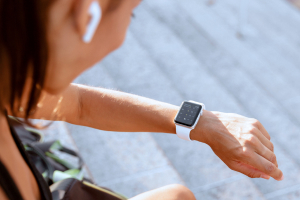Quick mental math challenge: How many Apple Watches can you buy with $118 billion dollars? If you guessed around 296 million watches congrats, you’re smarter than the writer of this blog! We had to use a calculator. The point is that’s the predicted size of the US wearable market by 2028 according to a recent report. That means for as much wearable tech as we have in our lives already, even more, is on the way.
If you own a piece of wearable tech it’s easy to understand why it’s so popular. After all, it can track our fitness, provide contextual help in daily life, and, in the case of hearing aids, even do cool things like sync with Bluetooth. As VR and AR gains a foothold who knows what other incredible tech might be headed our way by 2028? However wearable tech also comes with certain risks. The most prominent: cybercriminals potentially gaining access to your data.
How can criminals gain access to your wearable data?
The weakest link in the wearables space is your mobile phone, not the actual wearable device itself. That’s because wearables tend to link to your mobile device over a short-range wireless spectrum known as “Bluetooth.” This spectrum is used to send and receive data between your wearable device and your mobile. That makes your mobile a prime target for hackers.
Most commonly, hackers gain access to the data on your mobile through malware-laden apps. These apps are oftentimes designed to look like popular apps, but with enough differences that they don’t flag copyright suspicion.
What are they doing with my wearable data?
Hackers can use these malicious apps to do a variety of things from making phone calls without your permission, sending and receiving texts, and extracting personal information—all potentially without your knowledge. They can also, with the help of your wearable, track your location through GPS and record any health issues you’ve entered into your wearable. The point is: once they have permissions to your mobile device, they have a lot of control and a lot of resources.
The hacker can then use this data to conduct varying forms of fraud. Need a special prescription from your doctor that happens to sell well on the black market? Well, so does the hacker. Going out for a jog in the morning? Good information for a burglar to know. These personal details just scratch the surface of information available for the taking on your mobile devices.
Beyond wearables and into the internet of things
These types of threats aren’t limited to wearables, however. The Internet of Things—the phenomenon of devices connected to the Internet for analysis and optimization—encompasses all sorts of other electronic devices such as washing machines and refrigerators that can put your data at risk as well. But these life-changing devices can be secured through education and industry standards. Two things we’re working on day and night.
Defend your wearables and your personal information
- Use a PIN. All of your mobile devices ought to have a personal identification number (PIN). This basic security method is a great way of dissuading casual hackers or thieves from stealing your data.
- Limit what you share. Most wearables don’t need access to every piece of information about you. You can lessen the likelihood of your wearable sharing sensitive information by only entering the information your wearable device requires. On the flip side, always double-check the permissions that the wearables app is requesting on your mobile device. Does it really need access to your location, camera roll, and address book? If not, be sure to alter these settings appropriately.
- Use identity protection. Identity protection can monitor your accounts online – accounts tied to your wearable – so you can receive alerts if that information has been compromised or found online. If it has, a service like McAfee’s Identity Protection Service may also provide insurance and loss remediation as well.
Of course, securing the weakest link in your wearables environment, your phone will go a long way towards keeping your data safe. But what happens when your computer, where you store backups of your smartphone, is compromised too? We’ve got you covered with McAfee LiveSafe™ service, our comprehensive security solution that provides protection for your entire online life.
